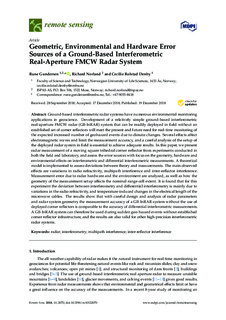| dc.contributor.author | Gundersen, Rune | |
| dc.contributor.author | Denby, Cecilie Rolstad | |
| dc.contributor.author | Norland, Richard | |
| dc.date.accessioned | 2019-02-15T08:41:41Z | |
| dc.date.available | 2019-02-15T08:41:41Z | |
| dc.date.created | 2019-01-09T11:30:52Z | |
| dc.date.issued | 2018 | |
| dc.identifier.citation | Remote Sensing. 2018, 10 (12), . | nb_NO |
| dc.identifier.issn | 2072-4292 | |
| dc.identifier.uri | http://hdl.handle.net/11250/2585610 | |
| dc.description.abstract | Ground-based interferometric radar systems have numerous environmental monitoring applications in geoscience. Development of a relatively simple ground-based interferometric real-aperture FMCW radar (GB-InRAR) system that can be readily deployed in field without an established set of corner reflectors will meet the present and future need for real-time monitoring of the expected increased number of geohazard events due to climate changes. Several effects affect electromagnetic waves and limit the measurement accuracy, and a careful analysis of the setup of the deployed radar system in field is essential to achieve adequate results. In this paper, we present radar measurement of a moving square trihedral corner reflector from experiments conducted in both the field and laboratory, and assess the error sources with focus on the geometry, hardware and environmental effects on interferometric and differential interferometric measurements. A theoretical model is implemented to assess deviations between theory and measurements. The main observed effects are variations in radio refractivity, multipath interference and inter-reflector interference. Measurement error due to radar hardware and the environment are analyzed, as well as how the geometry of the measurement setup affects the nominal range-cell extent. It is found that for this experiment the deviation between interferometry and differential interferometry is mainly due to variations in the radio refractivity, and temperature-induced changes in the electrical length of the microwave cables. The results show that with careful design and analysis of radar parameters and radar system geometry the measurement accuracy of a GB-InRAR system without the use of deployed corner reflectors is comparable to the accuracy of differential interferometric measurements. A GB-InRAR system can therefore be used during sudden geo-hazard events without established corner reflector infrastructure, and the results are also valid for other high-precision interferometric radar systems. | nb_NO |
| dc.description.abstract | Geometric, Environmental and Hardware Error Sources of a Ground-Based Interferometric Real-Aperture FMCW Radar System | nb_NO |
| dc.language.iso | eng | nb_NO |
| dc.relation.uri | www.mdpi.com/2072-4292/10/12/2070 | |
| dc.rights | Attribution-NonCommercial-NoDerivatives 4.0 Internasjonal | * |
| dc.rights.uri | http://creativecommons.org/licenses/by-nc-nd/4.0/deed.no | * |
| dc.title | Geometric, Environmental and Hardware Error Sources of a Ground-Based Interferometric Real-Aperture FMCW Radar System | nb_NO |
| dc.type | Journal article | nb_NO |
| dc.type | Peer reviewed | nb_NO |
| dc.description.version | publishedVersion | nb_NO |
| dc.subject.nsi | VDP::Elektronikk: 435 | nb_NO |
| dc.subject.nsi | VDP::Electronics: 435 | nb_NO |
| dc.source.pagenumber | 25 | nb_NO |
| dc.source.volume | 10 | nb_NO |
| dc.source.journal | Remote Sensing | nb_NO |
| dc.source.issue | 12 | nb_NO |
| dc.identifier.doi | 10.3390/rs10122070 | |
| dc.identifier.cristin | 1653074 | |
| dc.relation.project | Norges forskningsråd: 218784 | nb_NO |
| cristin.unitcode | 192,15,0,0 | |
| cristin.unitcode | 192,15,3,0 | |
| cristin.unitname | Realfag og teknologi | |
| cristin.unitname | Seksjon for geomatikk | |
| cristin.ispublished | true | |
| cristin.fulltext | original | |
| cristin.qualitycode | 1 | |

